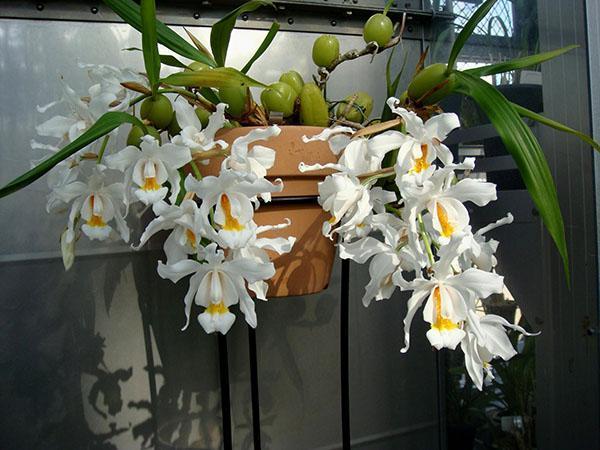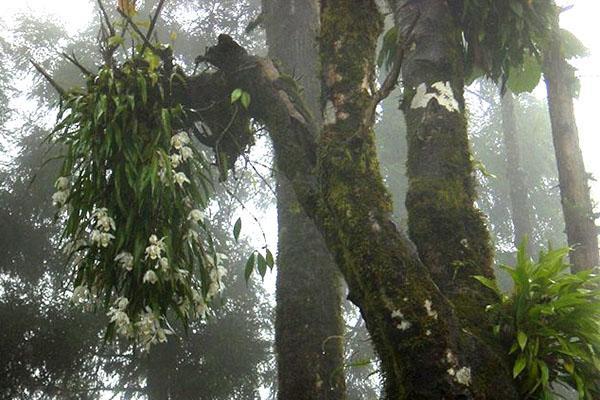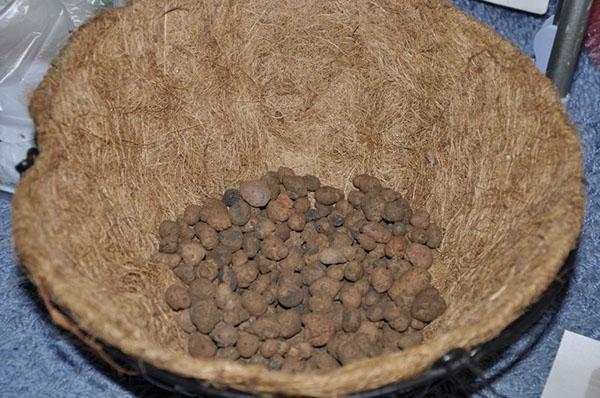Cellogin's orchid: cultivation, reproduction and collection of varieties
 A snow-white waterfall of inflorescences, falling over an emerald veil of greenery, takes the breath away even from the most sophisticated flower growers. In addition to such bright decorative properties, the cellogin orchid surprises with its diversity - more than 200 varieties.
A snow-white waterfall of inflorescences, falling over an emerald veil of greenery, takes the breath away even from the most sophisticated flower growers. In addition to such bright decorative properties, the cellogin orchid surprises with its diversity - more than 200 varieties.
- observe rest periods by creating cool conditions of detention;
- provide the flowerpot with high humidity;
- choose a porous substrate for good aeration of the root system.
The genus of this family belongs to epiphytes, which are often used as a support by other cultures. However, they feed on their own.
Their main feature is an unquenchable thirst for moisture. Therefore, before buying a luxurious exhibit, it is worth considering the possibility of creating favorable conditions for its exuberant prosperity. See:types of orchids - photos and names.
Cellogin's orchid: cultivation features
Meet an exotic flower in the Himalayan gorges, as well as on the coast of the Indian or Pacific Ocean. The subtropical / tropical climate in tandem with the impenetrable jungle creates perfect conditions for such "beauties". Unfortunately, it is impossible to create a similar setting in your house or apartment. However, there is something that anyone can do.
Planting Secrets
 The first step to successfully planting a cellogin orchid is choosing a pot. It should be wide, but not deep, since the roots grow in breadth, not in depth. The best option is transparent containers. However, both the bottom and the sides should have holes. Be sure to put on the bottom drainage - a layer of expanded clay.
The first step to successfully planting a cellogin orchid is choosing a pot. It should be wide, but not deep, since the roots grow in breadth, not in depth. The best option is transparent containers. However, both the bottom and the sides should have holes. Be sure to put on the bottom drainage - a layer of expanded clay.
If a grower buys a substrate in a store, then it is worth taking a fine-grained mixture. Most of it is pine bark. Decayed deciduous compost is not a superfluous ingredient.
For orchids cellogyne create a loose, light and porous soil that is able to retain moisture for a long time. Below are the options for such compositions:
Below are the options for such compositions:
- An obligatory element is pine bark. The maximum size of fractions is 1 cm.
- The disinfectant component is charcoal. Some add it in crushed form, while others put it in pieces.
- The loose base consists of sphagnum moss or coconut fiber... You can also experiment with Styrofoam. They take it as much as all the other parts.
- Fertilizers. Peat soil (up to 15-20%, because it burns the roots), crushed fern roots or deciduous compost will serve as an excellent top dressing.
Still, there are varieties that have very long roots (coelogyne fimbriata, which means fringed). Therefore, they are advised to grow on top of special blocks.  The rhizome is fixed on the pine bark with a wire. The resulting object is wrapped in a dense layer of sphagnum moss. As a result, the specimen will have to be watered and sprayed more often than usual.
The rhizome is fixed on the pine bark with a wire. The resulting object is wrapped in a dense layer of sphagnum moss. As a result, the specimen will have to be watered and sprayed more often than usual.
Subtleties of reproduction
 Too often, it is impossible to disturb the root system of the flowerpot. It is best to do this every 3 years. Sometimes activities are carried out in extreme cases:
Too often, it is impossible to disturb the root system of the flowerpot. It is best to do this every 3 years. Sometimes activities are carried out in extreme cases:
- the presence of diseases or pests;
- it's time to divide the bush;
- replacement of an impoverished substrate.
When the bush has grown too much, and the young shoots are far beyond the container, then the orchid is ready for transplant. Culture propagation is carried out by dividing rhizomes.  The basic principle of the process: on each new seedling there should be both young and old pseudobulbs (2-3 pcs.). It is important to inspect the root system so that it is well developed.
The basic principle of the process: on each new seedling there should be both young and old pseudobulbs (2-3 pcs.). It is important to inspect the root system so that it is well developed.
Spray the flowerpot very carefully, preferably over the moss, so that moisture does not collect in the middle of the bush. In summer, the procedure is repeated 2 times a day.
Next, a soil mixture is prepared: high-quality bark, coconut fiber and sphagnum. Expanded clay is laid at the bottom. Then they follow the basic rules of how to plant an orchid. The following technique is used:
- remove the flowerpot from the pot;
- remove the old substrate;
- remove dead roots;
- cut the bush into pieces with a sterile blade so that there are no lacerations;
- the cuts are sprinkled with crushed charcoal (activated or wood);
- seated in separate containers;
- fix for stability.
 Further care largely depends on the degree of development of the seedling. He will need moderate watering at first. With the advent of new roots, the soil is moistened much more often and is regularly sprayed.
Further care largely depends on the degree of development of the seedling. He will need moderate watering at first. With the advent of new roots, the soil is moistened much more often and is regularly sprayed.
A reservoir of water is placed next to the flowerpot so that the humidity is from 50%. The above measures will be successful if changes in the development of a mountain plant are noticed in time.
Acquaintance with the popular varieties of cellogin orchids
 Its varieties have many differences. Yet the distinctive feature of the genus is sympodial growth, that is, horizontal, not vertical. For example, the shoots of the coelogine crested stop growing at the end of the season. After a period of rest, young processes appear on the side of them. At their base, pseudobulbs are formed, which can be either spherical or angular in shape. The structure of the flower is unique: 5 elongated petals combined with a luxurious lower lip.
Its varieties have many differences. Yet the distinctive feature of the genus is sympodial growth, that is, horizontal, not vertical. For example, the shoots of the coelogine crested stop growing at the end of the season. After a period of rest, young processes appear on the side of them. At their base, pseudobulbs are formed, which can be either spherical or angular in shape. The structure of the flower is unique: 5 elongated petals combined with a luxurious lower lip.
Representatives of the celogyne family (especially the cristata orchid) have 2 rest periods. The first begins in October, so watering is minimized. The pot is transferred to a cool room (+ 12 °). The second comes in mid-March, when the bulbs begin to wrinkle.
Massange from the Malay Archipelago
 Experts note that with proper care, the culture blooms several times a year. In most cases, it pleases the owners in May or June. They will enjoy the amazing beauty for 2 weeks. The coelogin of the massage is easy to recognize by the following characteristics:
Experts note that with proper care, the culture blooms several times a year. In most cases, it pleases the owners in May or June. They will enjoy the amazing beauty for 2 weeks. The coelogin of the massage is easy to recognize by the following characteristics:
- large (10 cm wide) and long (50 cm) leaves with coarse veins;
- dimensional peduncle reaching 60 cm in length;
- small flowers (from 15 to 20) of a cream shade with a leopard elongated lip;
- cone-shaped pseudobulbs (up to 10-12 cm), which are covered with refined grooves.
Unlike other members of the genus, she prefers a warmer climate. Therefore, when transferring a flowerpot to a cold room, it is important to closely monitor its “well-being”. If he is healthy, then a flower arrow will always form from each compacted shoot.
In some cultivated varieties, flower stalks develop with the beginning of growth. Therefore, they are watered both during the growing season of the buds and after flowering. It is at this moment that young leaves / roots are laid.
Rohussena loosens her hair
 When this inhabitant of the tropics of Malaysia blossoms, it forms an original necklace of small buds (about 50 pieces) of a cream shade. This Hawaiian "garland" will decorate the house from February to April. At the same time, the inflorescences will fill the house with a pleasant lemon scent.
When this inhabitant of the tropics of Malaysia blossoms, it forms an original necklace of small buds (about 50 pieces) of a cream shade. This Hawaiian "garland" will decorate the house from February to April. At the same time, the inflorescences will fill the house with a pleasant lemon scent.
 To understand how to grow Rohussen's cellogyne, special talents are not needed. The scheme remains standard. The substrate is moistened as it dries. Watering is enhanced when laying pseudobulbs and developing a peduncle. After flowering, the pot is supposed to rest.
To understand how to grow Rohussen's cellogyne, special talents are not needed. The scheme remains standard. The substrate is moistened as it dries. Watering is enhanced when laying pseudobulbs and developing a peduncle. After flowering, the pot is supposed to rest.
Cold-blooded Kristata
 An amazing variety with snow-white flowers found exceptionally high in the Himalayan mountains. Unlike its relatives, the culture calmly tolerates the cold, since it grows near snowy hills.For this reason, caring for Christata's cellogyne at home is quite simple. It is reduced to the observance of 2 periods of rest, a characteristic feature of which is the night temperature drop (+ 12 ° C). Although watering at this time is reduced, however, the humidity around the flowerpot is maintained within 70-80%.
An amazing variety with snow-white flowers found exceptionally high in the Himalayan mountains. Unlike its relatives, the culture calmly tolerates the cold, since it grows near snowy hills.For this reason, caring for Christata's cellogyne at home is quite simple. It is reduced to the observance of 2 periods of rest, a characteristic feature of which is the night temperature drop (+ 12 ° C). Although watering at this time is reduced, however, the humidity around the flowerpot is maintained within 70-80%.
Some gardeners grow this variety on loggias (glazed) on the north side. The place is chosen shady with diffused access of light.
In the botanical description of the crested plant (Cristata), it is important to mention its globular slightly elongated pseudobulbs (3-5 cm). Two fleshy leaves emerge from them, in the center of which an arrow grows with 3-8 snow-white flowers. Some of them reach 10 cm in diameter.
Here are just a few varieties of the cellogin orchid. Separately, you can explore such varieties as terry, beautiful, drooping (another name for Flacida) or Pandurata. The variety of their shapes and colors fascinates even the most fastidious gardeners.